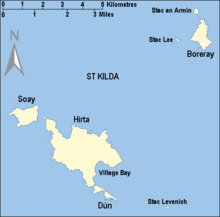Stac Biorach

| Scottish Gaelic name | Stac Biorach |
|---|---|
| Meaning of name | "sharply pointed stack"[1] |
| Location | |
| OS grid reference | NA071013 |
| Coordinates | 57°49′44″N 8°37′19″W / 57.829°N 8.622°W |
| Physical geography | |
| Island group | St Kilda |
| Highest elevation | 73 m (240 ft)[2] |
| Administration | |
| Sovereign state | United Kingdom |
| Country | Scotland |
| Council area | Outer Hebrides |
| Demographics | |
| Population | 0 |
| References | [3] |

Stac Biorach (Scottish Gaelic: "the pointed stack") is a sea stack, 73 metres tall, situated between Hirta and Soay (in the "Sound of Soay") in the St Kilda archipelago of Scotland. It lies west of Stac Shoaigh (Soay Stac) (61 metres).[3]
57°49′44″N 8°37′18″W / 57.82889°N 8.62167°W
History
The stack has never been inhabited, but has contributed considerably to the local economy by supplying the St Kildans with sea birds and their eggs. Rev. Neil MacKenzie, a Church of Scotland minister who resided on St Kilda from 1830 to 1844, observed the islanders collecting eggs from here in baskets like flat-bottomed bee hives, each basket holding about 400 eggs.[citation needed]
Recreational climbing
Recreational climbing on the stack seems to have started in the early 1880s. It appears that the first non-St Kildan to climb the stack was Richard Manliffe Barrington; he ascended Stac Biorach in 1883.[4] calling it the most dangerous climb he ever undertook.[5] Today climbing in all of the St Kilda archipelago is subject to the permission of the National Trust for Scotland[6] (which rarely grants it). The stack is difficult to climb and "one which only a few of the natives could lead."[7][8]
In 2023 a small group of British climbers, including Robbie Phillips from Edinburgh, completed the climb, the first documented ascent in 133 years.[9]
Birdlife
Like the other islands in the St Kilda archipelago, Stac Biorach is extraordinarily rich in birdlife, and boasts the highest colony of guillemots in the archipelago.[10]
See also
Notes
- ^ Haswell-Smith 2004, pp. 322–23.
- ^ Mellor 2020, p. 139.
- ^ a b Ordnance Survey. OS Maps Online (Map). 1:25,000. Leisure.
- ^ Barrington 1913, pp. 199–201.
- ^ Heathcote, Norman (1901). "Climbing in St Kilda". Scottish Mountaineering Club Journal. 6. Scottish Mountaineering Club: 146–151. Retrieved 8 February 2009. p. 148.
- ^ National Trust for Scotland 2003, p. 103.
- ^ Steven, Campbell Rodger (1975). The Story of Scotland's Hills. R. Hale. p. 39. ISBN 978-0-7091-4975-0.
- ^ According to one source, the stack was climbed by R.M. Barrington in 1929 rather than 1890. Maclean, St. Kilda: Island on the Edge of the World, 103.
- ^ “St Kilda sea stack scaled for first time since 1890”. BBC News Retrieved 4 December 2023.
- ^ Maclean 1992, p. 99.
References
- Barrington, Richard M. (1913). "The Ascent of Stack-Na-Biorrach (The Pointed Stack), St Kilda". Alpine Journal. 27. London: Longmans, Green: 195-202.
- Maclean, Charles (1992). St. Kilda: Island on the Edge of the World. Canongate Press. ISBN 978-0-86241-388-0.
- Haswell-Smith, Hamish (2004). The Scottish Islands. Edinburgh: Canongate. ISBN 978-1-84195-454-7.
- Mellor, Chris (January 2020). "An illustrated guide to sea stack climbing in the UK & Ireland" (PDF). needlesports. Retrieved 23 January 2021.
- St Kilda Management Plan 2003-2008 (PDF). National Trust for Scotland. 2003.

